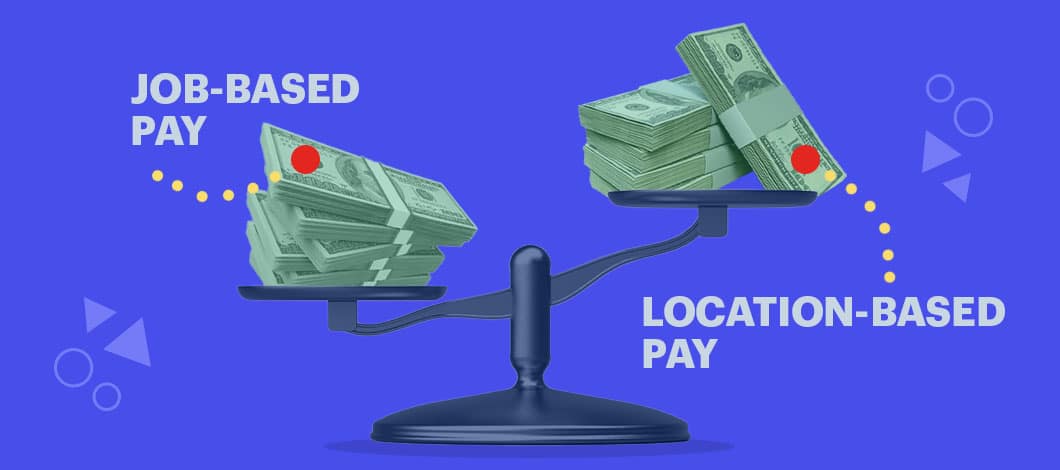With more employees working from home, more employers are adopting location pay for remote workers.
But is location-based pay the best way to go? We’ll cover what employers need to know about location pay. We’ll start by looking at what location pay is and how location affects pay. Then we’ll consider why some workers and employers prefer location-based pay, what its pros and cons are and whether it’s a good policy for remote workers. Finally, we’ll offer some suggestions on how to handle location-based pay should you choose to implement it.
What Is Location Pay?
Location pay is compensation adjusted based on where the employee lives. It stands in contrast to job-based pay, where pay is based exclusively on the employee’s job description and experience without location factoring in.
Location pay comes in a couple of varieties. One method of handling location pay is offering additional compensation for workers located in areas with a high cost of living. An alternative is adjusting pay for all workers based on location.
Employers typically use location pay when workers are located at multiple locations. The rise of remote work during the COVID-19 pandemic has made location pay more popular.
As of September 2021, 45% of full-time U.S. employees were working from home either part-time or all of the time, according to data from analytics firm Gallup. Location-based pay is now used by 62% of employers, while 67% of workers expect their pay to be adjusted based on their location, according to a study by WorldatWork, a nonprofit association dedicated to total compensation, a notion of factoring in benefits such as well-being and development with wages.
How Does Location Affect Pay?
The underlying reason that location affects pay is that the cost of living varies from one place to the next. For example, in January 2020, the average cost of monthly rent in San Francisco was $3,700, compared with $4,210 in Manhattan, according to real estate site Bungalow. Correspondingly, average incomes in San Francisco exceeded $100,000, while in Manhattan they stood at $164,000. Such wide variations make location a key factor in how employers set pay rates.

Why Do Some Workers and Employers Prefer Location-Based Pay?
Location pay appeals both to employees and employers for related reasons. Employees in areas with a high cost of living need higher pay to afford their expenses and enjoy a comfortable lifestyle. This makes them favor employers who are willing to accommodate their living expenses with corresponding pay.
From the employer’s side, location-based pay can help attract talented workers from markets with high costs of living. This can improve both employee recruitment and retention. It also can help employers save money when recruiting workers from areas with lower costs of living.
What Are the Pros and Cons of Job-Based Pay vs. Location-Based Pay?
For employers, one of the big reasons for using location-based pay is to make compensation packages more attractive to top talent. Offering employees from areas with high costs of living higher compensation can make them more inclined to accept a job offer, especially if competitors are offering location-based pay. This can help employers compete with local businesses that may be offering higher compensation.
Likewise, higher compensation based on location can increase employee retention rates. This helps employers maintain productivity while reducing recruitment costs.
Cons of Location Pay
On the other hand, location-based pay may cost you more for the same work. This may be a particular drawback in industries where competition for workers isn’t as intense as it is in industries that employ remote workers extensively.
Location-based pay may backfire if some workers learn they aren’t being compensated the same as highly paid workers. This can create resentment if there is a perception of unfairness.
Another complication is that if you hire workers from remote locations, you need to stay in compliance with income tax, payroll tax and benefit laws where they live. However, if you hire remote workers, you will face this issue whether you use location-based pay or job-based pay.
There also is the question of how to handle it if remote workers change locations. Workers who move to an area with a lower cost of living may be reluctant to accept a pay cut.
A long-term concern about location-based pay is that it may artificially push up pay in certain industries to levels that are unaffordable for many employers. For example, if employers throughout the U.S. have to pay tech workers based on prices set in San Francisco, this may make it difficult for some employers to compete for talent. This is more likely to affect certain industries than others.

Should Remote Workers Be Paid Less With Location-Based Pay?
Location-based pay doesn’t necessarily imply working from home compensation should be less for remote workers. In some cases, it may mean higher pay for workers in locations with higher costs of living. In other cases where workers are located in areas with lower costs of living, it may mean lower pay. There’s no general rule for how much remote workers should be paid using location-based pay.
A key consideration when deciding how much to pay remote workers is whether higher pay based on location will increase your ability to attract and retain talented workers. Consider whether you can find the same talent locally. Also, consider whether your business can attract remote talent using job-based pay rather than location-based pay.
How to Handle Location-Based Pay
If you decide to go with location pay, it’s important to follow some best practices. Here are some guidelines on how to pay remote workers using a location-based model:
- Make sure your location pay policy supports your business goals, such as your recruitment and retention goals
- Use consistent standards for setting location-based pay
- Set location pay levels based on compensation research derived from resources such as Glassdoor
- Factor in how location pay adjustments fit into the value of the total compensation package for remote employees
- Establish policies for what to do when remote employees change locations
- Have your human resources team verify compliance with all laws applicable where your remote workers are located
- Make sure your location pay adjustments apply equally to all employees and don’t discriminate based on nonlocation factors
- Be transparent about your policies
Use these guidelines to help you implement location-based pay successfully.
Is Location-Based Pay Right for Your Business?
Location pay adjusts compensation based on the cost of living where remote workers are located. This can help attract remote workers from areas with high costs of living, improving recruitment and retention.
However, it can have potential drawbacks, including raising your costs and complicating your payroll management. Effective location-based pay policies require adherence to best practices such as following consistent standards, researching compensation and being transparent.
Ultimately, location-based pay makes sense when it helps your recruitment and retention without imposing an undue cost burden. Do a cost-benefit analysis of your specific situation to determine whether location-based pay is right for your business.










